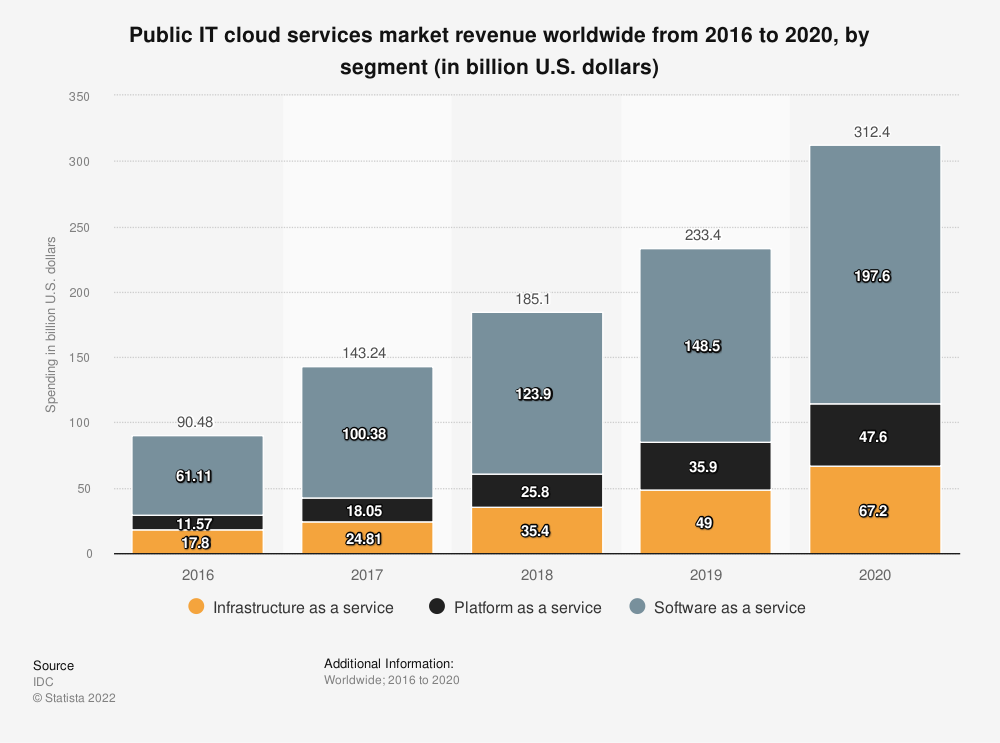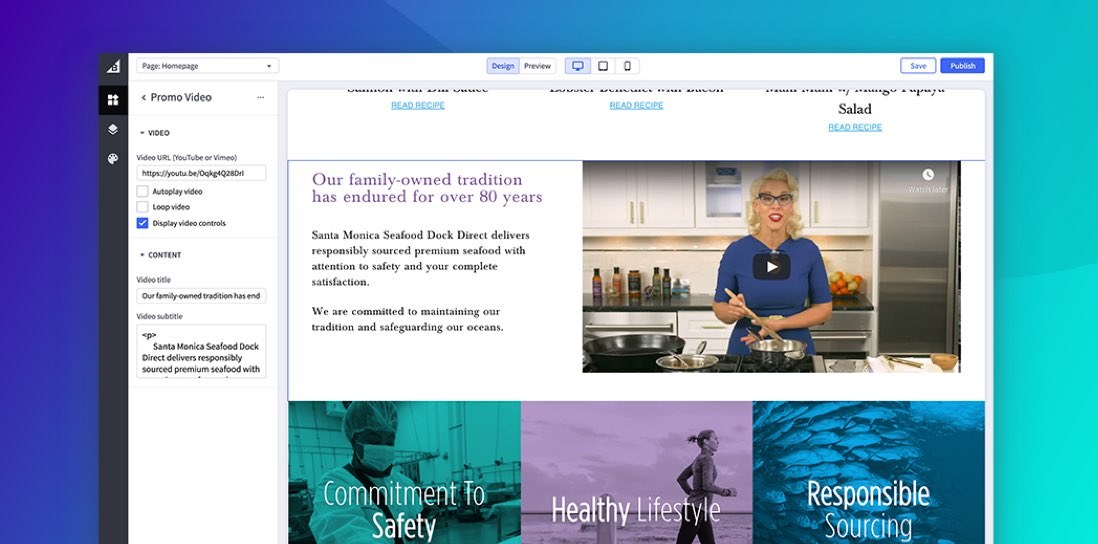- Enterprise
- Essentials
SaaS vs. PaaS vs. IaaS: What You Need to Know

See What Open SaaS Can Do For Your Business
With the increased popularity of cloud computing and services, businesses across the globe are moving away from the traditional on-premise services that they have come to rely on.
Cloud-based services have transformed how businesses have worked, allowing them to use IT infrastructures, platforms, software and applications via the Internet and online hotspots.
For organizations who are considering moving their ecommerce business to the cloud, there are three important terms to be aware of:
- Infrastructure as a Service (IaaS).
- Platform as a Service (PaaS).
- Software as a Service (SaaS).
IaaS, PaaS and SaaS are the three main types of cloud computing available today.
These platforms have grown significantly over the last decade, with its worldwide revenue increasing from around $90 billion in 2016 to more than $312 billion in 2020.

With growth like this, cloud computing is quickly becoming the norm as businesses begin to phase out on-premise software altogether.
The Key Differences Between On-Premise, SaaS, PaaS, IaaS
Not so long ago, most of a company’s IT systems were on-premises and clouds were just white fluffy things in the sky. Now, everyone can utilize cloud-based platforms for nearly all your systems and processes.
SaaS, PaaS and IaaS present three modern but different ways to describe how you can use the cloud for your business.
It is important to remember that most businesses using cloud-based platforms use a combination of SaaS and IaaS cloud computing service models, and many engage developers to create applications using PaaS, too.
SaaS
SaaS platforms involve software that is available via third-party over the Internet.
Examples of popular SaaS providers include:
- BigCommerce.
- Google Workspace, Salesforce.
- Dropbox.
- MailChimp.
- ZenDesk.
- DocuSign.
- Slack.
- Hubspot.
PaaS
PaaS focuses primarily on hardware and software tools available over the internet.
Examples of popular PaaS providers include:
- AWS Elastic Beanstalk.
- Heroku.
- Windows Azure (mainly used as PaaS).
- Force.com.
- Google App Engine.
- OpenShift.
- Apache Stratos.
- Adobe Magento Commerce Cloud.
IaaS
IaaS works primarily with cloud-based and pay-as-you-go services such as storage, networking and virtualization.
Examples of popular IaaS providers include:
- AWS EC2.
- Rackspace.
- Google Compute Engine (GCE).
- Digital Ocean.
- Microsoft Azure.
- Magento 1 Enterprise Edition*.
The 3 Types of Cloud Computing Service Models Explained
1. IaaS (Infrastructure as a Service).
IaaS, also known as cloud infrastructure services, provides end users with cloud-based alternatives to on-premise, physical infrastructure, allowing businesses to purchase resources on-demand instead of the more costly venture of having to buy and manage hardware.
IaaS characteristics.
IaaS is scalable and offers businesses greater flexibility than on-premise solutions through the cloud. IaaS businesses typically provide services such as pay-as-you-go storage, networking and virtualization.
IaaS cloud servers are typically offered to businesses over the internet, whether through a dashboard or an API, ensuring users have complete control over their computing infrastructure.
IaaS platforms are:
- Highly flexible and highly scalable.
- Accessible by multiple users.
- Cost-effective.
IaaS advantages.
Maintaining on-premise IT infrastructure can be costly and labor-intensive as it often requires a significant initial investment in physical hardware. You will also probably need to engage skilled external IT contractors to maintain the hardware and keep everything working and up-to-date.
With IaaS, you can buy what you need, as you need it, and purchase more as your business grows.
IaaS solutions are highly flexible and scalable and can be replaced whenever needed without losing money on your initial investment.
Another advantage of IaaS is it puts control over the infrastructure back in your hands. You will no longer need to place trust in an external IT contractor — you can access and oversee IaaS products yourself if you wish, without being an IT wiz.
IaaS disadvantages.
There are certain limitations and concerns when it comes to transitioning to IaaS, including:
- Legacy systems: Before a full migration to the cloud is completed, any legacy technology or applications should be reviewed for compatibility. There are many older systems that are not designed for cloud-based services and may need to be upgraded or replaced.
- Security: With the move from on-premise to the cloud, there could be new security threats, whether sources from the host or other virtual machines (VMs). It is critical that organizations review and research up-to-date security threats and their remediation strategies.
- Internal Training: With a new system comes a lack of familiarity with its intricacies. Businesses should prepare additional training and resources to ensure their users know what they are doing.
When to use IaaS.
IaaS is beneficial to businesses of all shapes and sizes. It allows complete control over your infrastructure and operates on a pay-as-you-use model, which fits into most budgets.
With most IaaS platforms, you get access to ongoing support and have the option of scaling up your requirements at any time.
Utilizing IaaS is an excellent way to future-proof your business.
IaaS non-ecommerce example.
A good example of IaaS is AWS EC2.
EC2 delivers scalable infrastructure for companies that want to host cloud-based applications. EC2 users do not own the physical servers — AWS provides virtual servers.
Users only pay for the usage of the servers, saving them the cost — and associated ongoing maintenance — of investing in physical hardware.
IaaS ecommerce example.
Adobe Commerce (Magento) can be used either on-premise or IaaS, depending on how the merchant chooses to host their store.
In the case of IaaS, the merchant is paying Magento for the licensing of the software and then using a third-party vendor for the best web hosting such as Rackspace.
Merchants are able to pay for a hosting plan that meets their own needs without the cost of maintaining their own physical servers. The merchant is still responsible for installing and managing updates to their Magento software.
2. PaaS (Platform as a Service).
PaaS, also known as cloud platform services, provides developers with a framework, software and tools needed to build apps and software — all accessible through the internet.
Often seen as a scaled-down version of IaaS, PaaS gives its customers broader access to servers, storage and networking, all managed by a third-party provider.
PaaS characteristics.
PaaS delivery is comparable to SaaS methods, with the main difference being that customers are not able to access online software but an online platform.
PaaS provides that platform for software developers to create, allowing them to concentrate on the software itself instead of any external issues.
PaaS platforms are:
- Accessible by multiple users.
- Scalable — customers can choose from various tiers of computing resources to suit the size of their business.
- Built on virtualization technology.
- Easy to run without extensive system administration knowledge.
PaaS advantages.
PaaS is primarily used by developers who are building software or applications.
A PaaS solution provides the platform for developers to create unique, customizable software meaning that developers don’t need to start from scratch when developing applications — saving them time and money on writing extensive code.
PaaS is a popular choice for businesses who want to create unique applications without spending a fortune or taking on all the responsibility. It’s similar to the difference between hiring a venue to put on a show vs. building one yourself to put on a show.
The venue stays the same, but what you create in that space is unique.
PaaS disadvantages.
Like IaaS, there are certain drawbacks to using PaaS that companies should be aware of, including:
- Integrations: With PaaS, you may encounter challenges when integrating new applications. This is tied into issues related to legacy systems since there are often aspects of these systems that aren’t built for the cloud.
- Data security: Using third-party servers for your data could potentially lead to additional security risks. Security options may also be limited since you will have to find a solution that can integrate with the third-party systems.
- Runtime: PaaS solutions may not be fully optimized for the language and frameworks your business uses and finding a specifically tailored solution may be difficult.
- Operational limitations: Customized cloud operations may not be compatible with PaaS solutions, especially those with management automation workflows. This can inhibit your operational capabilities and limit the full scope of your business.
When to use PaaS.
PaaS is often the most cost-effective and time-effective way for a developer to create a unique application.
PaaS allows the developer to focus on the creative side of app development as opposed to the menial tasks such as managing software updates or security patches. Instead, their time and brainpower can go into creating, testing and deploying the app.
PaaS non-ecommerce example.
A good example of PaaS is AWS Elastic Beanstalk.
Amazon Web Services (AWS) offers over 200 cloud computing services such as EC2, RDS, and S3. Most of these services can be used as IaaS, and most companies who use AWS will pick and choose the services they need.
However, managing multiple services can quickly become difficult and time-consuming for users.
That’s where AWS Elastic Beanstalk comes in. It works as another layer on top of the infrastructure services and automatically handles the details of capacity provisioning, load balancing, scalability, and application health monitoring.
PaaS ecommerce example.
Adobe Commerce (Magento) is the most common example of PaaS for ecommerce. It enables the merchant to bundle their hosting as part of their package with Magento.
Merchants evaluating Magento go through a scoping process to determine their hosting needs, bundled into their monthly plan. You will have full access to edit the source code of their Magento store and can fully customize the application.
Any platform updates, security patches and general maintenance to their store would be the merchant's responsibility.
3. SaaS (Software as a Service).
SaaS, also known as cloud application services, is the most commonly used service within the cloud market. SaaS platforms make software available to users over the internet, usually for a monthly subscription fee.
They are typically ready-to-use and run from a users’ web browser, which allows businesses to skip any additional downloads or application installations.
SaaS characteristics.
SaaS is delivered through the internet as a full functional service, accessible via any web browser. With SaaS, vendors manage the data, servers and storage, ultimately eliminating the need for IT review and streamlining business processes.
SaaS platforms are:
- Available over the Internet.
- Hosted on a remote server by a third-party provider.
- Ideal for small businesses or startups who cannot develop their own software applications.
- Scalable, with different tiers for small, medium and enterprise-level businesses.
- Inclusive, offering security, compliance and maintenance as part of the cost.
SaaS advantages.
With SaaS, you don’t need to install and run software applications on your computer. Everything is available over the internet when you log in to your account online. You can usually access the software from any device, anytime — as long as there is an internet connection.
The same goes for anyone else using the software. All your staff will have personalized logins suitable to their access level. You no longer need to engage an IT specialist to download the software onto multiple computers throughout your office or worry about keeping up-to-date software on every computer. It’s all taken care of in the Cloud.
Another key advantage is the payment structure.
Most SaaS providers operate a subscription model with a fixed, inclusive monthly account fee. You know precisely how much the software will cost and can budget accordingly without worrying about hidden surprises.
Subscriptions can potentially include maintenance, compliance and security services. SaaS providers also offer out-of-the-box, simple solutions to set up if you need a basic package, with more complex solutions for larger organizations. You could have the basic software up and running within a matter of hours – and you’ll have access to customer service and support along the way.
SaaS disadvantages.
Like IaaS and PaaS, there are limitations and concerns about SaaS, including:
- Data Security: With data primarily located in off-premise servers, security could potentially become an issue. Ensure that you have the right security solutions in place and are comfortable with whichever SaaS service you are using.
- Interoperability: Integrations with existing applications and services can be a concern since many SaaS apps are not designed for open integrations. Finding a service with integration capabilities can be difficult, and attempting to create your own can be worse.
- Customization: SaaS services typically allow minimal customization for features, capabilities and integrations. This can force companies to invest significant resources into managing or adding customization capabilities.
- Lack of control: With a SaaS solution, businesses often have to hand over ultimate control to the third-party service providers — giving them the keys to functionality, performance and even data. You will want to ensure that you trust the provider used or have the ability to review your information remotely.
When to use SaaS.
SaaS platforms are ideal for when you want an application to run smoothly and reliably with minimal input from you.
Take your email server, for example.
You want to know that you can continue to send and receive emails without needing to fiddle with your email settings or worry about updates. Imagine if your email server went under because you forgot to update it? That’s simply not an option in today’s marketplace.
If you use SaaS applications to run your email inbox, the chances of something going wrong are very small, and if something did go wrong, it would be up to the SaaS provider to find a solution.
You’re not only paying for the SaaS applications/products — you’re paying for peace of mind.
SaaS non-ecommerce example.
Google Workspace — formerly known as Google G Suite — is one of the most popular SaaS-based infrastructure services. The upgrade from G Suite came as a result of a more integrated experience across Google’s broader suite, which allowed its customers to better connect with their various tools.
The Google Workspace suite features applications people are aware of, such as Gmail, Google Calendar, Google Docs and more.
SaaS ecommerce example.
An excellent example of a SaaS ecommerce platform is BigCommerce.
BigCommerce is one of the leading SaaS ecommerce platforms for mid-market and enterprise brands. It has all the benefits associated with multi-tenant SaaS — ease of use, high-performance, and continuous updates — coupled with platform-wide APIs that enable businesses to customize their sites and integrate with external applications and services.
BigCommerce provides complete shopping cart software and hosting infrastructure to the user, allowing businesses to create an online shop within minutes without worrying about coding, hosting or software.
The BigCommerce platform also has regular updates that automatically roll out for users, and software licenses, upgrades, and hosting costs are all covered in the monthly subscription fee.
Make It Big 2022 Conference
Watch our Make It Big 2022 conference and get ready to level up.
WATCH FOR FREEThe Final Word
Ultimately, what are the differences between IaaS, PaaS, and SaaS?
- IaaS is there to provide you with maximum flexibility when it comes to hosting custom-built apps, as well as providing a general data center for data storage.
- PaaS is most often built on top of an IaaS platform to reduce the need for system administration. It allows you to focus on app development instead of infrastructure management.
- SaaS offers ready-to-use, out-of-the-box solutions that meet a particular business need (such as a website or email). Most modern SaaS platforms are built on IaaS or PaaS platforms.
The increasing popularity of IaaS, PaaS, and SaaS has reduced the need for on-premise hosting. As businesses and technology continue to merge, migrating to the cloud becomes paramount for organizations looking to remain on the cutting edge.
These cloud delivery models give users choices, flexibility and options that on-premise hosting simply cannot provide.
FAQs About SaaS vs PaaS vs IaaS
What is the best option, SaaS or PaaS or IaaS?
The answer is dependent on your business. Each cloud service model offers different features and functionalities.
If you want out-of-the-box features, without the hassle of installations, then SaaS may be the best option for you.
If you need a platform designed for building software products, then PaaS would help your business immediately.
If you are looking for a highly flexible, scalable service — while maintaining control of its infrastructure — then IaaS is the right choice for you.
What differentiates PaaS from SaaS?
The most significant difference between PaaS and SaaS is that SaaS products are fully managed by another company, from the servers to the data itself. With PaaS, you are able to use the cloud-based platform as a foundation for building software.
If you want to create your own applications for your business, then PaaS platforms are the best option.
What is the difference between IaaS and PaaS?
The greatest difference between IaaS and PaaS comes from who controls the system.
With IaaS, administrators gain more direct control over operating systems. On the other hand, users gain greater flexibility and control over proprietary applications or programs with PaaS.
How does the SaaS model differ from the IaaS model?
With both IaaS and SaaS, the cloud service providers manage servers, networking, virtualization and storage.
However, unlike SaaS, those who use IaaS are still responsible for managing some aspects of their business, including applications, runtime, middleware and data. SaaS is the more out-of-the-box option, while IaaS maintains a small level of control.



